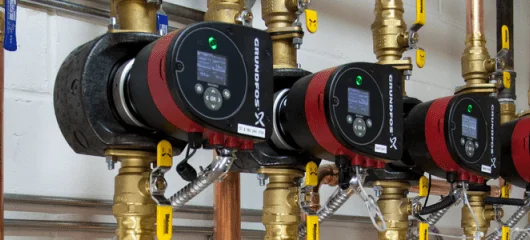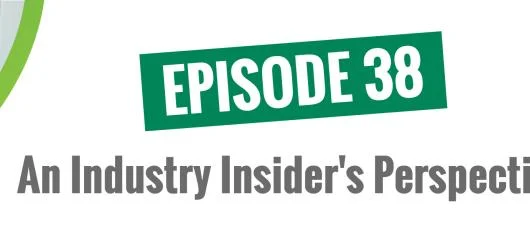Best practice is to pump away from the mixing valve, not into it. Connect the suction side of the pump to the mixed outlet port of the valve. This will assure proper flow direction and balanced pressures at the hot and cold inlet ports, and will promote constant system flow and good hot/cold mixing around the thermostatic element. We sometimes hear about a pump discharge being piped to the hot inlet of a thermostatic mixing valve. In that case, the pump head pressure might prevent cold water from entering the cold inlet port, or worse, hot water can be pushed through the valve into the cold inlet piping. If there is no cold inlet flow, the thermostatic element will see only hot water and will close down the hot inlet port, deadheading the pump and reducing system flow.
Related, for proper control, be sure to select the right size mixing valve. The Caleffi 521 Series has a minimum flow rate of 1.3 GPM and will flow 10 GPM at a pressure drop of 10 PSI. The larger 5231 Series can handle flow rates up to 70 GPM, for larger commercial applications.










Hi Kevin, I’m based in the UK and I’m looking to use the 521 mixing valve to regulate temperature to my domestic hot water manifold. However I’m using a whole house pump due to very poor mains pressure. I’ve attached a diagram of how I was going to complete the setup with my 1000L buffer store and plate heat exchanger.
The whole house pump will be a Grundfos Amazon Extra ch4-30.
As I would be using a whole house pump which will provide equal pressure to both sides of the 521 is this still an issue, and if so do you have any suggestions?
Thanks
Chris
Hi Chris, As long as your mixing valve hot/cold inlet pressures are close to equal, your system should work as your sketch shows. I recommend using the model with check valves on the inlets. Our partner in the UK, Altecnic, might have some additional suggestions for you.
I am setting up a hot water system for our house using a Sanden CO2 heat pump and our existing radiant floor system and domestic water system.The Sanden uses a 83 gallon tank to store the hot water. It is really important that the water in the tank remain stratified such that when the heat pump turns on it receives cold water rather than hot water to maintain the best performance. The top of the tank is at 150*f.
I will be using a Taco x-pump block to transfer heat from the tank to the radiant floor. If the inlet to the Taco is 140* F or so then the out is 120+- which is too warm for the heat pump. I want the floor water at 85*F
I am thinking if I use a mixing valve to feed the Taco I can decrease the input temperature to 110 and get return water to the tank at a lower temperature.. I would feed hot and cold from the tank to valve, mixed to Taco where pump pulls the water and out from Taco to cold line that feeds the mixing valve and is connected to cold of tank.
Do you see any issues with this setup? Thanks Rod
Rod,
Thank you for your questions and so sorry for the late reply!
It is my understanding that the X Pump Block by Taco offers a variable speed pump on the heat source side to control temperature to the load side. To this point, if your hot water source is 140 it will likely slow the water down significantly through the heat exchanger to achieve the load side temperature you desire. This will create a large temperature difference between the supply and return of the heat source and will facilitate stratification that you desire!
I'm concerned though that the X Pump Block may be a bit more than what is needed. This is especially true if you do not need a heat exchanger. Please call when you have a moment so that we can talk this through!
Best Regards,
Cody Mack
Applications Engineer
Caleffi North America
414-238-2360
My question is related to this topic and it is about the following code:
"607.2.2 Piping for Recirculation Systems Having Master Thermostatic Valves: Where a thermostatic mixing valve is used in a system with a hot water recirculating pump, the hot water or tempered water return line shall be routed to the cold water inlet pipe of the water heater and the cold water inlet pipe or the hot water return connection of the thermostatic mixing valve."
My concern is that the return line of the recirculation of loop can be too warm to be used in mixing valve. For instance, let's assume that the water heater is set to 140F, and we need 120F at the output of the mixing valve. If the return line temperature is 115F and connected to cold supply line of the mixing valve, can the mixing valve still work properly?
Do you have sample drawings showing this scheme?
Sorry for the late reply!
We do have a diagram for that exact scenario. Please see page 6 of the linked document below.
https://www.caleffi.com/sites/default/files/file/01050_17_na.pdf
You'll notice in the drawing that I linked to above that the return line goes to both the cold water inlet of the mix valve and to the tank but they are separated by a check valve in the cold line. Also notice that each of these lines has a valve to regulate flow (preferably globe valves). With the system piped and operating per our drawing and there is no draw from the system you're correct that the cold inlet will be too warm. This is the reason for the globe valves to regulate flow to the cold water inlet and through the tank. During this time, the mixing valve is not a big part of the equation.
I hope that this helps. If you have any further questions, please call our office and we'll be happy to help
Cody Mack
Applications Engineer
Caleffi NA
414-335-6217
Hi,
I recently bought a property with an electric boiler in the garage (for both the house and the garage), and am installing gas and a gas boiler in the house now.
I am hearing different things about the temperature of the water/glycol mixture going into the floor slabs in the basement of the house, and on the garage slab as well.
Both slabs have nothing on top of them as of now, and I am wondering what the maximum temperature the pex piping in both slabs can handle safely ?
The pex pipes both have ratings of 180 deg F, and I am thinking of running the output boiler temp up to 160 deg F, on the coldest days of the year in Canada.
Or do I need a missing valve to temper the boiler temperature going into the slabs? Thanks for any answers.
In reply to Hi, by Jeff
Jeff,
Sorry for the late reply!
The temperature of the fluid flowing through the slabs will be dependent on how much tubing (radiation) you have in the slabs and what the heat loss of the structure is. I've seen many older homes from the 1950/60s use soft copper in the floor using 160 degree water. Today's newer systems are typically designed around much lower water temperatures to accommodate high efficiency boiler options that will be more efficient with return water temperatures below 130 degrees.
I would strongly suggest getting in touch with a contractor to help you make the correct decision.
Best Regards,
Cody Mack
Applications Engineer
Caleffi North America
414-238-2360
Hi,
I have a 1980's Valliant boiler with baseboard fin convectors and there is no boiler protection installed. The issue I am having is that I want to install a mixing valve for boiler protection, but the pump is attached to the bottom of the boiler on the return line. It's a single pipe monoflo system and it works fine, my dilemma is that I would love to keep the system as is with a single pump, but after glancing over the install instructions for some of these mixing valves, I see that they are meant for primary secondary pumping. Can a mixing valve be installed without affecting functionality of the system while keeping it single pump?
In reply to Hi, by Pete C
Pete,
I think the first question is do you have a problem with the boiler condensing? If yes, what is causing it?
Fin tube convectors are designed to be used with higher temp. (non condensing) water. If the boiler had condensation issues since installation it's likely that the boiler would have already been replaced by now. If the condensing has just started, you really need to figure out what is causing it.
Even in high temp applications like fin tube, the boiler may still condense a bit when warming up but it should be minimal and go away very shortly.
If you're still in the market for a boiler protection valve you could look at our 280 series valve that is designed for just this. It can be used in a single pump system but you have to remember that it will add pressure drop which could cause flow problems in your system. At that point, a primary/secondary set up may be necessary.
https://www.caleffi.com/sites/default/files/file/01223_17_na.pdf
Best Regards,
Cody Mack
Applications Engineer
Caleffi North America
414-238-2360
Hi Cody and Team,
I'm looking at using one of your mixing valves on a system with a large storage tank and a recirculating loop for hot water.
The storage tank is primarily heated by solar thermal panels and in the summer, the temperature ideally reaches 80-90 degrees celsius.
These temperatures would be dangerous to send to the faucets so the intention is to place the mixing valve in the re-circulation loop to bring the temp down to around 50 degrees.
My concern is that in the configurations outlined in the various caleffi manuals for installation in a re-circulation situation, the storage tank temperature will be reduced during times when there is little or no draw from the faucets.
I.e. the hot water leaves the tank at 90 degrees Celsius and goes around reaches the thermostatic mixing valve. Cold water is added to brind the temperature down to 50 degrees Celsius which is then sent around the re-circulation loop. On return, some of this water is sent back into the tank and some is sent back to the mixing valve along with more cold to be mixed with hot to circulate again. So suddenly the lovely hot water in the tank is starting to rapidly lose 40 degrees all the time while the re-circulation is on.
Of course the numbers are not this exact but hopefully it illustrates how I am understanding the functioning of the mixing valve. Is my understanding incorrect? Any thoughts and comments and help towards my understanding would be greatly appreciated.
Thank you!
In reply to Hi Cody and Team, by Saul
Hello Saul,
The only time that the mix valve will be bringing in fresh, cold water is when there is a demand from the fixtures. Ideally, the mixing valve would be at the point of distribution (tank or hot water source) and it would mix down the high temp water to whatever temperature you desire using the slightly cooler water from the recirculation return. Take a look at our technical brochure for some application diagrams that may be helpful.
https://www.caleffi.com/sites/default/files/file/01050_17_na.pdf
Best Regards,
Cody Mack
Caleffi North America
Hi Cody,
Thanks for coming back to me - much appreciated.
Understood on the addition of new fresh cold when the fixtures demand water.
I guess the scenario that I don't yet understand is when the system lies unused for say 2-3 days and the solar thermal gets the whole tank up to 90 Degrees Celsius. With the circulation loop on (and the mix valve set to say 50 Degrees Celsius, what happens?
In this scenario, no water leaves the system so no new fresh cold should come in but as the re-circ loop is highly insulated, even the return from the re-circ will not be low enough to mix down to 50.
Perhaps I have a fundamental misunderstanding - if so - my apologies - I'm keen to learn and understand :)
Thanks Cody!
Regards,
Saul
Hello,
I am curious, if multiple mixing valves are installed in parallel, does this allow for a higher gpm?
THank you,
Yes, parallel installation of mixing valves is common. Both the max flow rate and the min flow rate double. Make sure the double minimum flow rate is met (a recirculation pump will help, if used) so the valves have enough flow to provide stable control.
I would like to install a 2 way sensing valve in a radiant system , non electric, supply side before the manifold, using a bypass piping..This comes from a Dan Holohan "Pumping Away"sketch. Possible? Wrong approach? Thanks, B K
Hi BK. We can't be sure...can you e-mail us a copy of the sketch you refer to? Send to techsupport.us@caleffi.com or upload it here in the Ask Caleffi page, and we will reply.